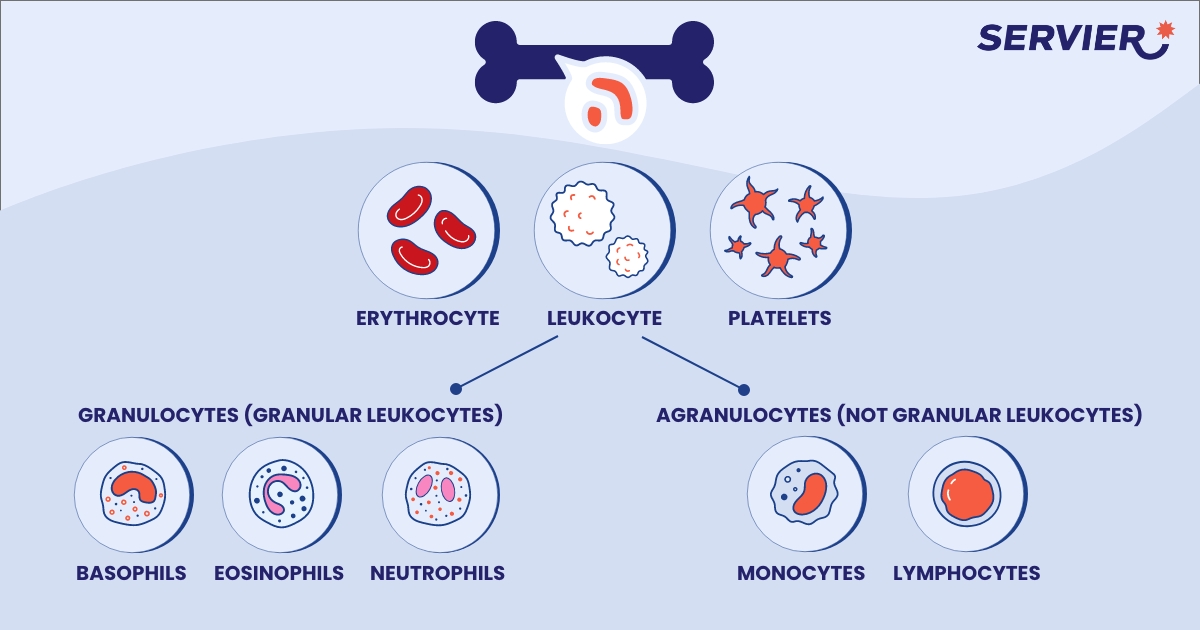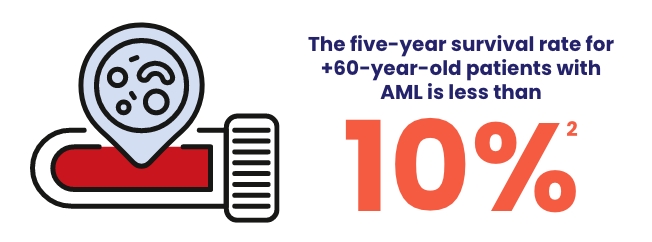
In 2019, the most recent year for statistics, 1,160 Canadians were diagnosed with Acute Myeloid Leukemia (AML)1, a rare, aggressive form of blood and bone marrow cancer.
Understanding acute myeloid leukemia
According to the Canadian Cancer Society, Acute myeloid leukemia (AML) is a cancer that starts in stem cells of the blood, basic cells that develop into different types of cells with different jobs. As the stem cells develop, they become blast cells (blasts), or immature blood cells.
Acute myeloid leukemia (AML) is a rare, very aggressive type of blood and bone marrow cancer that mainly affects adults.
This cancer is a proliferation of immature cells, i.e., cells that are not sufficiently developed and therefore cannot function normally. These cancer cells are present in the blood, which is why we speak of “leukemia”; they come from a myeloid blast, hence the term “myeloid.”
There are many types of leukemia, based on the type of blood stem cell they developed from, either myeloid stem cells or lymphoid stem cells.
Myeloid leukemias develop from abnormal myeloid stem cells. Normally, myeloid stem cells develop into different types of mature blood cells – red blood cells, platelets,
granulocytes and monocytes.

The types of leukemia are further grouped depending on how quickly the leukemia develops
and grows. Acute leukemia starts suddenly and develops within days or weeks. Chronic leukemias usually develop slowly over months or years.
About acute myeloid leukemia in this video:
Understand its impact

AML incidence rate in Canada excluding Quebec in 20193:
The age-standardized rates per 100,000 population are stable across time. However, changes in total population and older age group populations are increasing the total number of cases.
- Both sexes: 4.2
- Male: 4.9
- Female: 3.6
Servier is dedicated to research & innovation
AML progresses quickly, making timely research and innovation more important than ever.
At Servier, our ambition is to accelerate the research and discovery of new therapeutic solutions for the long-term well-being of our patients and their families.
Our team is dedicated to patient needs

Since cancer never stops, our vital work never stops either. Over 70% of Servier’s R&D budget is dedicated to developing advances in oncology. At Servier, our goal is to be an innovative player in cancer treatments, especially for hard-to-treat underserved cancers such as AML. Our R&D programs have a two-pronged approach: immuno-oncology and targeted therapies. 4
Working with patients

We work with patients at every stage of the medicine lifecycle to best meet their needs. And we partner with global networks, such as the Acute Leukemia Advocates Network (ALAN) and local patient organizations like the Leukemia Lymphoma Society of Canada (LLSC) to identify and better serve the needs of people living with leukemia 5.
For more information about AML:
Leukemia and Lymphoma Society of Canada
Canadian Cancer Society
1. Canadian Cancer Society, https://cancer.ca/en/cancer-information/cancer-types/acute-myeloid-leukemia-aml/statistics, extracted on January 29, 2025.
2. Betul Oran and Daniel J. Weisdorf, Survival for older patients with acute myeloid leukemia: a population-based study, extracted on February 24th, 2025.
3. Statistique Canada, Number and rates of new cases of primary cancer, by cancer type, age group and sex, extracted on April 01st, 2025.
4. Servier Canada, https://servier.ca/en/our-news/targeted-therapies-as-cancer-treatments/ , Extracted on January 29th, 2025.
5. Leukemia and Lymphoma Society of Canada, https://www.bloodcancers.ca/i-have-blood-cancer/leukemia/acute-myeloid-leukemia-aml extracted on January 29th, 2025.



